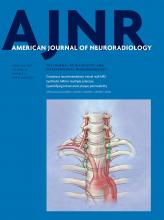Index by author
Cui, J.
- EDITOR'S CHOICEFunctionalOpen AccessMicrostructure of the Default Mode Network in Preterm InfantsJ. Cui, O. Tymofiyeva, R. Desikan, T. Flynn, H. Kim, D. Gano, C.P. Hess, D.M. Ferriero, A.J. Barkovich and D. XuAmerican Journal of Neuroradiology February 2017, 38 (2) 343-348; DOI: https://doi.org/10.3174/ajnr.A4997
A cohort of 44 preterm infants underwent T1WI, resting-state fMRI, and DTI at 3T, including 21 infants with brain injuries and 23 infants with normal-appearing structural imaging as controls. Neurodevelopment was evaluated with the Bayley Scales of Infant Development at 12 months' adjusted age. Results showed decreased fractional anisotropy and elevated radial diffusivity values of the cingula in the preterm infants with brain injuries compared with controls. The Bayley Scales of Infant Development cognitive scores were significantly associated with cingulate fractional anisotropy. The authors suggest that the microstructural properties of interconnecting axonal pathways within the default mode network are of critical importance in the early neurocognitive development of infants.
Daemen, M.J.A.P.
- ADULT BRAINOpen AccessIntracranial Vessel Wall MRI: Principles and Expert Consensus Recommendations of the American Society of NeuroradiologyD.M. Mandell, M. Mossa-Basha, Y. Qiao, C.P. Hess, F. Hui, C. Matouk, M.H. Johnson, M.J.A.P. Daemen, A. Vossough, M. Edjlali, D. Saloner, S.A. Ansari, B.A. Wasserman and D.J. Mikulis on behalf of the Vessel Wall Imaging Study Group of the American Society of NeuroradiologyAmerican Journal of Neuroradiology February 2017, 38 (2) 218-229; DOI: https://doi.org/10.3174/ajnr.A4893
Darsaut, T.E.
- NeurointerventionYou have accessTesting Stenting and Flow Diversion Using a Surgical Elastase-Induced Complex Fusiform Aneurysm ModelR. Fahed, T.E. Darsaut, I. Salazkin, J.-C. Gentric, M. Mazighi and J. RaymondAmerican Journal of Neuroradiology February 2017, 38 (2) 317-322; DOI: https://doi.org/10.3174/ajnr.A5018
Dehkordi, F.H.
- ADULT BRAINOpen AccessImpact of Pial Collaterals on Infarct Growth Rate in Experimental Acute Ischemic StrokeG.A. Christoforidis, P. Vakil, S.A. Ansari, F.H. Dehkordi and T.J. CarrollAmerican Journal of Neuroradiology February 2017, 38 (2) 270-275; DOI: https://doi.org/10.3174/ajnr.A5003
- EDITOR'S CHOICEADULT BRAINOpen AccessQuantifying Intracranial Plaque Permeability with Dynamic Contrast-Enhanced MRI: A Pilot StudyP. Vakil, A.H. Elmokadem, F.H. Syed, C.G. Cantrell, F.H. Dehkordi, T.J. Carroll and S.A. AnsariAmerican Journal of Neuroradiology February 2017, 38 (2) 243-249; DOI: https://doi.org/10.3174/ajnr.A4998
The purpose of this study was to use DCE MR imaging to quantify the contrast permeability of intracranial atherosclerotic disease plaques in 10 symptomatic patients and to compare these parameters against existing markers of plaque volatility using black-blood MR imaging pulse sequences. Ktrans and fractional plasma volume (Vp) measurements were higher in plaques versus healthy white matter and similar or less than values in the choroid plexus. Only Ktrans correlated significantly with time from symptom onset. Dynamic contrast-enhanced MR imaging parameters were not found to correlate significantly with intraplaque enhancement or hyperintensity. The authors suggest that Ktrans may be an independent imaging biomarker of acute and symptom-associated pathologic changes in intracranial atherosclerotic disease plaques.
Desikan, R.
- EDITOR'S CHOICEFunctionalOpen AccessMicrostructure of the Default Mode Network in Preterm InfantsJ. Cui, O. Tymofiyeva, R. Desikan, T. Flynn, H. Kim, D. Gano, C.P. Hess, D.M. Ferriero, A.J. Barkovich and D. XuAmerican Journal of Neuroradiology February 2017, 38 (2) 343-348; DOI: https://doi.org/10.3174/ajnr.A4997
A cohort of 44 preterm infants underwent T1WI, resting-state fMRI, and DTI at 3T, including 21 infants with brain injuries and 23 infants with normal-appearing structural imaging as controls. Neurodevelopment was evaluated with the Bayley Scales of Infant Development at 12 months' adjusted age. Results showed decreased fractional anisotropy and elevated radial diffusivity values of the cingula in the preterm infants with brain injuries compared with controls. The Bayley Scales of Infant Development cognitive scores were significantly associated with cingulate fractional anisotropy. The authors suggest that the microstructural properties of interconnecting axonal pathways within the default mode network are of critical importance in the early neurocognitive development of infants.
Dorembus, S.
- Pediatric NeuroimagingYou have accessFetal Brain Anomalies Associated with Ventriculomegaly or Asymmetry: An MRI-Based StudyE. Barzilay, O. Bar-Yosef, S. Dorembus, R. Achiron and E. KatorzaAmerican Journal of Neuroradiology February 2017, 38 (2) 371-375; DOI: https://doi.org/10.3174/ajnr.A5009
Edjlali, M.
- ADULT BRAINOpen AccessIntracranial Vessel Wall MRI: Principles and Expert Consensus Recommendations of the American Society of NeuroradiologyD.M. Mandell, M. Mossa-Basha, Y. Qiao, C.P. Hess, F. Hui, C. Matouk, M.H. Johnson, M.J.A.P. Daemen, A. Vossough, M. Edjlali, D. Saloner, S.A. Ansari, B.A. Wasserman and D.J. Mikulis on behalf of the Vessel Wall Imaging Study Group of the American Society of NeuroradiologyAmerican Journal of Neuroradiology February 2017, 38 (2) 218-229; DOI: https://doi.org/10.3174/ajnr.A4893
El-deiry, M.
- Head and Neck ImagingYou have accessCT Accuracy of Extrinsic Tongue Muscle Invasion in Oral Cavity CancerJ.C. Junn, K.L. Baugnon, E.A. Lacayo, P.A. Hudgins, M.R. Patel, K.R. Magliocca, A.S. Corey, M. El-Deiry, J.T. Wadsworth, J.J. Beitler, N.F. Saba, Y. Liu and A.H. AikenAmerican Journal of Neuroradiology February 2017, 38 (2) 364-370; DOI: https://doi.org/10.3174/ajnr.A4993
Elmokadem, A.H.
- EDITOR'S CHOICEADULT BRAINOpen AccessQuantifying Intracranial Plaque Permeability with Dynamic Contrast-Enhanced MRI: A Pilot StudyP. Vakil, A.H. Elmokadem, F.H. Syed, C.G. Cantrell, F.H. Dehkordi, T.J. Carroll and S.A. AnsariAmerican Journal of Neuroradiology February 2017, 38 (2) 243-249; DOI: https://doi.org/10.3174/ajnr.A4998
The purpose of this study was to use DCE MR imaging to quantify the contrast permeability of intracranial atherosclerotic disease plaques in 10 symptomatic patients and to compare these parameters against existing markers of plaque volatility using black-blood MR imaging pulse sequences. Ktrans and fractional plasma volume (Vp) measurements were higher in plaques versus healthy white matter and similar or less than values in the choroid plexus. Only Ktrans correlated significantly with time from symptom onset. Dynamic contrast-enhanced MR imaging parameters were not found to correlate significantly with intraplaque enhancement or hyperintensity. The authors suggest that Ktrans may be an independent imaging biomarker of acute and symptom-associated pathologic changes in intracranial atherosclerotic disease plaques.
Fahed, R.
- NeurointerventionYou have accessTesting Stenting and Flow Diversion Using a Surgical Elastase-Induced Complex Fusiform Aneurysm ModelR. Fahed, T.E. Darsaut, I. Salazkin, J.-C. Gentric, M. Mazighi and J. RaymondAmerican Journal of Neuroradiology February 2017, 38 (2) 317-322; DOI: https://doi.org/10.3174/ajnr.A5018








